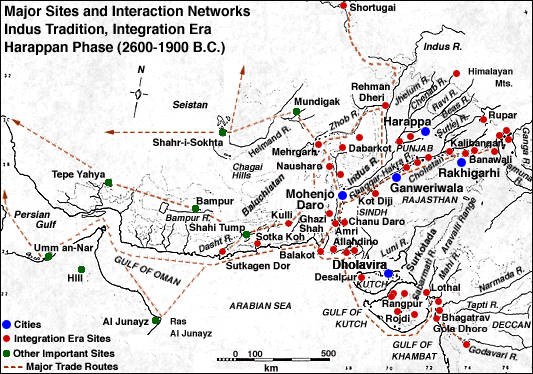Before we begin, Remember: Harappan Civilization is also known as Indus Valley Civilization
The Discoverers of Indus Valley Civilization:
- Alexander Cunningham – He was the first Director-General of ASI. He Began excavations around mid nineteenth century.
- John Marshall – He was the DG of ASI in 1927 and first professional Archaeologist of India.But he excated horizontlly and all finds were grouped together even when they were found at different stratigraphic layers. This caused loss of very valuable information regarding.
- R.E.M. Wheeler – He followed the stratigraphy of excavations rather than just excavating horizontally.
Basic features of Indus Valley Civilization:
- The Indus Valley civilization is the first known Urban Culture in India.
- Majority of the sites developed on the banks of river Indus, Ghaggar and its tributaries.
- This civilisation is credited for building cities complete with : town planning, sanitation, drainage system and broad well-laid roads.
- They also built double storied houses of burnt-bricks complete with bathroom , kitchen, and a well.
- Their Walled cities had important buildings such as, the Great Bath, Granaries and the Assembly Halls.
- Thier Agriculture was considered major occupation for rural areas.While the City residents were involved in internal & external trade which led to developed contacts with other civilizations ( e.g. Mesopotamia).
- Harappans were excellent potters as is evident by their artifacts.
- Harappans also had technical knowledge of metals & process of alloying (e.g. bronze sculpture of dancing girl found in Mohenjodaro).
- Also, Shell, ivory, bone and faience were used as material for different crafts.
- Here, Lothal deserves special mention as the site for dockyard. It is situated in Ahmedabad, Gujarat.
- Lothal was a well planned walled city which was an important centre of sea trade with the western world.
- Other important cites were- Dhaulavira (Guj.) & Kalibangam (Rajasthan).
- Harappans used to worship plants, animals and the forces of nature.
- They also worshipped male god resembling Lord Shiva of later times and a mother goddess.
- They also probably believed in life after death and also in charms and spells.
- Their Seals were engraved with animal figures (e.g. humped bull, elephant and rhinoceros). This suggests that these animals were considered sacred.
- The image of ‘Peepal’ tree is found depicted on many seals.
- Harappan script is yet to be deciphered. Hence, our knowledge of Harappan civilization is solely based on archaeological evidence alone.
- Harappans were the first people to cultivate cotton. They knew the art of spinning & weaving.
Important sites of Indus Valley Civilisations
Firstly, lets look at major sites:
- Harappa was an urban center. It is in Punjab Province of Pakistan, located on an old river-bed of River Ravi.
- Mohenjo Daro is located in Sindh province of Pakistan, which is next to the river Indus.
- Dholavira is situated on ‘Khadir Beyt’, which is an island in Rann of Kutch,Gujarat, India.
- Lothal is located near the Sabarmati river and Arabian sea, in the Gulf of Khambat, Gujarat, India.
- Rakhigarhi was discovered in Haryana, India only in 1990.
- Ganeriwala is located in Punjab province of Pakistan and is very near to the Indian border.
Minor Sites are also being excavated with reference to Indus Valley Civilization:
- ‘Gola Dhoro’ or Bagasara is a site located in Gujarat, India.
- Daimabad is located in Maharashtra near Mumbai.
- Chanhudaro is located just 80 miles south of Mohenjo Daro in Sindh, Pakistan. It has been established a manufacturing center.
- Sutkagen Dor is located in Baluchistan. It is also the westernmost site of Harappan civilization.
<<<< Read about Vedic Civilization and culture here >>>>
Many questions are asked based on these sites in various exams like SSC, IBPS, CDS, NDA, UPSC civil services and state public service commission exams. It is advised to revise these details multiple times to answer the questions asked in these exams. Many times candidates get confused about minor details and tend to loose marks over such simple and basic topic even after reading and knowing about it.





